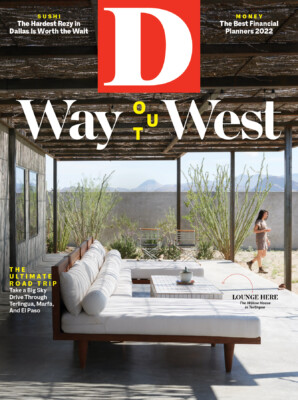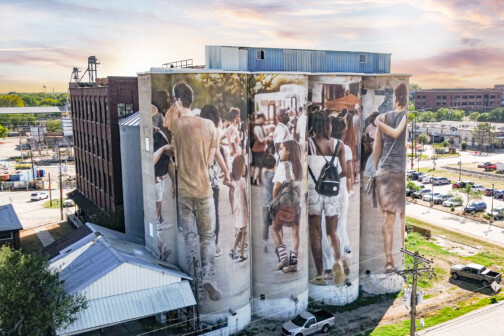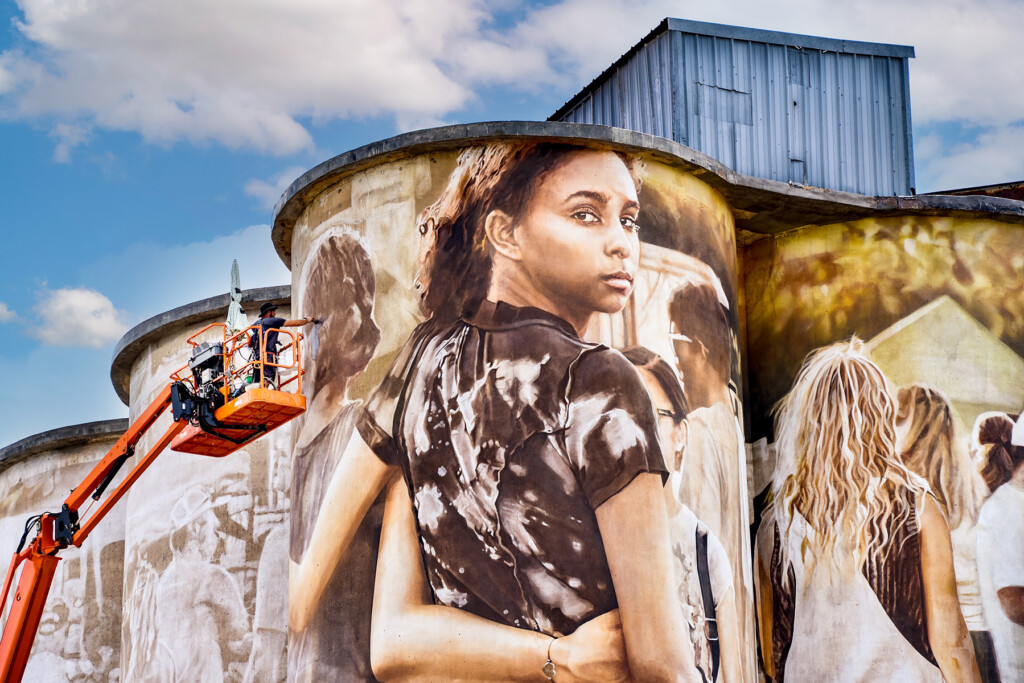From November 2022

Zoe King never imagined that she would be painted on a 100-foot-tall mural in her hometown of McKinney.
But in late August, 15-year-old Zoe and her mom, Trice, were on their way to Oklahoma to visit Zoe’s grandparents. Zoe’s father sent them both a screenshot from Facebook. There was Zoe, nearly fully painted, on the side of the towering grain silos off East Virginia and Main Street in the heart of where she grew up.
Zoe and her mother thought the screenshot was fake. It had to be a cunning Photoshop or sleight of hand projection; these were 100-foot tall grain silos, and, besides, where would the artist have gotten the idea? The picture looked too real. But a few Google searches later, they stumbled on McKinney’s Silo Mural Project and the artist Guido Van Helten. The Australian is known for creating oversized photorealist murals across the world. Suddenly, both Zoe and Trice knew the painting they saw in the screenshot from Facebook was real.
“At first, I was so confused,” Zoe says, smiling in between sips of water at Spoons Café in downtown McKinney. “When I was Googling, I found out it was a painting, but then I was more confused because why was I painted? It was just so weird.”
For Trice, what started as confusion quickly turned into wonder.

“I was just absolutely blown away at the talent of the artist,” Trice said. “That was my baby. It was her legs. Her posture. It was very accurate. To paint something that big and that detailed… I enjoyed seeing it.”
The painting wasn’t finished when the Kings first came across that image. When Zoe and her mother returned from Oklahoma, they went to see Van Helten in action. They expected a big operation. But it was just him, on a scaffold, with his paintbrush.
Van Helten took more than 5,000 photographs around town, trying to find inspiration for a mural that would represent the community in McKinney. He visited several city events, but he felt he was missing something. His biggest hurdle is trying to find a single image to represent a city.
He found his muse at McKinney’s second-annual Juneteeth celebration last summer. After experiencing the atmosphere at the festival, it dawned on him that the image he was searching for—one that embodied love and acceptance in McKinney—was suddenly in front of him, Trice says.
That is how he landed on the photo of Zoe.
His biggest hurdle is trying to find a single image to represent a city.
Tipped off by her mother that someone was taking photos that day, Zoe turned around to see who it was. Her mom’s arm was still around her waist, displaying a level of public affection teenagers rarely show to parents. Zoe’s slight turn of the head and her gentle stare are now frozen in time for as long as the paint lasts.
Van Helten also views the work as a challenge to those who may have made false assumptions about North Texas. “All of my work across America has been about stereotypes, uncovering them and breaking them down,” he says. “Even within America there’s a stereotype of Texas. The people in the Dallas area are from all different cultures, and I don’t think Texas is known for that.”
How an Aussie Illustrated McKinney
Guido van Helten’s oversize photorealistic murals have taken him all over the world, from his native Australia to Scandinavia and across Europe and the United States.
The internationally celebrated visual artist and photographer first discovered street art as a child in inner-city Melbourne. Perched high above the ground on a boom lift, he uses industrial spray guns and brushes to paint with mineral silicate concrete paint on high-rises and other structures. But the scale of his projects isn’t necessarily his biggest hurdle; oftentimes it is trying to find a single image to represent a city.
Depicting a relatively quiet suburban area such as McKinney is even more challenging than other places he’s painted, such as Athens, Sicily, or Tehran. “When you’re just passing through on the highway, you don’t really think there’s much to it,” he says. To learn more, he talked to residents, befriended small-business owners, and visited places of worship. He spoke to people of different ages and ethnicities. But it was at a Juneteenth celebration in the park, which he went to on a whim, where the artist finally found the inspiration he needed.
Justin Beller, city council representative for the district where the mural resides, wrote on Facebook that he sees his constituency in the image: “Our community has a rich history of gathering and celebration. We have parades at the 4th of July and Christmas. We have Juneteenth, Fiesta, and Dia de los Muertos. We have Oktoberfest and Arts in Bloom. Some of these events are rooted in over a century of history of gathering and celebrating in this community. In this artwork, I see a celebration, and as a viewer, I feel that I am invited to be a part. A girl is turned back towards us, inviting us to join the gathering.” He continues, “I can also see it this way: a crowd, moving forward towards a shared destination. A gathering of our community. A celebration. And a girl turned to look at our past, where we’ve come from.”
— Ginni Beam
While doing his research, he met many people who had moved to this area from various states and countries, such as El Salvador and Ghana, to start work or a new life. “At the end of the day, they’re all Texans,” he says. “I don’t think they’re very much different.”
“The fact that that was the image chosen shows how the community is growing,” Trice said. “It’s becoming more diverse. And Zoe’s very comfortable in her own skin. Even when being in McKinney, Texas, as a Black girl, she’s very comfortable with herself and in the community. That comes across. She feels at home here.”
Trice is speaking from experience. Growing up in small-town Texas, she has seen how the state has changed. The idea that the northern suburb of McKinney would celebrate Juneteeth was so groundbreaking that she made sure her family attended the festival – despite June’s oppressive heat.
Through that citywide celebration, Zoe’s image, along with the other residents plastered on the sides of the grain silos, serves as a reminder of what community means in McKinney.
“It shows that motherly, daughterly love and connection,” Zoe says. “It shows the community and how we really are. People always stereotype Texas, like we are all cowboys or something, but we are not like that.
“I think it’s important that I represent the Black community in McKinney because it’s just as much my home as it is anyone else’s. We are all in this together. This is all our homes.”
Zoe’s dad, Anthony, often takes her to ballet dance class down the street from the silos. During the drive, he jokes that Zoe is watching over the city.
There is always a little morsel of truth in that joke. Zoe, the literal person, may not be watching directly over McKinney, but Zoe—what she represents as an idea for the city—observes and inspires the notion of community.
And, sure, Zoe admits it feels strange.
Her friends think the mural is cool, she says. Most of the reactions came from her neighbors who saw the mural in passing or on a news broadcast. Everyone offered some form of congratulations, praise, adulation, or all three.
Yet, it’s the story behind the painting—a day at McKinney’s Juneteeth celebration, a Black girl depicted showing affection for her Black mother, and the youthful hope that exists in that over-the-shoulder stare—that speaks directly to what it means for Zoe to be “the guardian of McKinney.” That’s worth more than the attention generated by the grain silos mural.
“I’m glad that I can be an inspiration,” Zoe says “But this is not about me. It’s what it represents. It’s so cool being able to represent my town and my home; where I live and where I dance. It’s me up there, showing people that this is our community, and that is so nice.”





